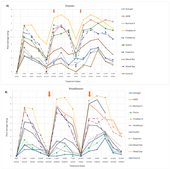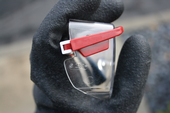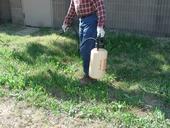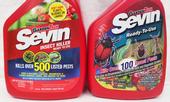- Author: Karey Windbiel-Rojas

Weed management in landscaped areas can be challenging. Weeds may need to be controlled for public safety, fire reduction, aesthetics, and elimination of harborage for other pests. While many nonchemical options for controlling weeds exist—such as physical removal with tools, steam, flame or steam devices, grazing animals, and others—there are some situations that may require the application of herbicides.
For decades, glyphosate has been a common active ingredient used to control weeds in both agricultural and nonagricultural settings. However, there has been significant public concern about the use of glyphosate and other herbicides due to their potential...
- Author: Lisa A Blecker
- Author: A. Katrina Hunter
- Posted by: Elaine Lander

Public concern regarding the risk of illness from long-term exposure to glyphosate is on the rise. In order to reduce exposure to this common herbicide, or any other pesticide, it's important that applicators wear the right personal protective equipment (PPE), not only for personal safety, but also to comply with California regulations.
Signal words and glyphosate
Pesticide labels contain a signal word, which describes the effects of acute or immediate toxicity from unprotected exposure to the chemical. Signal words are CAUTION, WARNING, DANGER, and DANGER-POISON (see the Spring 2019 issue of the retail newsletter for more

UC ANR's charge is research and extension and we provide guidance about how to manage weeds using registered pesticides and by non-chemical methods. UC ANR includes information in its publications on how to effectively and safely use glyphosate where it is legal to do so as well as provide options for alternative chemical and non-chemical approaches for managing weeds.
UC ANR recognizes that the use of any pesticide carries risks, including in some cases the possibility of acute (immediate), chronic (long term) or carcinogenic effects, to those who may be exposed to them. This is true of any pesticide, which includes herbicides such as glyphosate.
UC ANR has not specifically addressed carcinogenicity or other health...
- Author: Belinda J. Messenger-Sikes
- Author: Karey Windbiel-Rojas

We all have our favorite products, whether it's laundry detergent, shampoo, or a pesticide you know works against the pests in your home or garden. But what happens when a company changes the ingredients in a product? Does it work, smell, or lather differently?
You may visit a store looking for a pesticide product by name, not realizing that several popular pesticide brands have recently changed their active ingredients (the materials in pesticide products that actually...
- Author: Jeannette E. Warnert

Weeds are easiest to control when they are tiny emerging plants, reported Jeanette Marantos in a Los Angeles Times blog post. Marantos got tips on weed management from Cheryl Wilen, UC Cooperative Extension integrated pest management advisor in Southern California.
Wilen recommends home gardeners use a swivel (or hula) hoe to scrape the surface and decapitate weeds. “It's a bit of exercise,” she said, "but you can do it so quickly, it's not a problem.”
Another weed control strategy is a thick layer of mulch, with does double-duty by...


